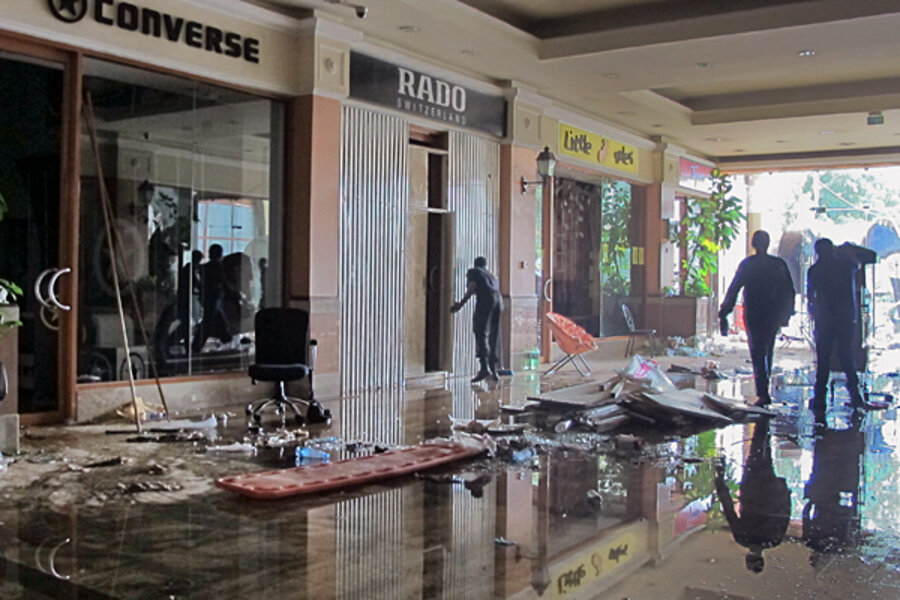Kenya: A week after Westgate mayhem ends, Al Shabab is gloating
Loading...
| Nairobi, Kenya
A week after Kenyan forces ended the siege of the Westgate mall here, relatives of the 39 people still listed as missing were asked to gather at a city morgue to give DNA samples.
The grim task points to one of the many questions that still remain after Kenya’s deadliest terror attack in 15 years: What happened to the hostages believed to have been trapped inside the shopping center?
That is not the only question. The identities of the attackers are not known, nor have their weapons been found, nor have the Kenyans explained how the arsenal was assembled, leading the suspected culprits, Somalia’s Al Shabab, to gloat about the confusion.
In fact, most aspects of what happened remain a mystery. Shop owners, however, have finally been able to assess the damage to their property and have given vivid descriptions of the destruction inside, while also raising allegations of looting during the siege.
On Tuesday nine bodies were recovered from the rubble at the rear of the building, where three floors collapsed, trapping and killing an unknown number of the attack gang and shoppers and staff. DNA of the victims will be matched to the database of family members in an attempt to identify those who died during the chaotic climax of the four-day ordeal.
Uhuru Kenyatta, Kenya’s president, this week promised to set up a public inquiry into the assault, which left at least 61 civilians, 6 soldiers, and 5 attackers dead, according to the government.
The president refused to withdraw Kenyan troops from Somalia, where they are battling the same Islamist army, Al Shabab, that said it sent the gang of as many as 15 people who took control of the Westgate mall on Sept. 21, unleashing mayhem and shocking Kenya and the world.
In an e-mailed statement on Wednesday, Al Shabab repeated that one reason for the assault was the Kenyans’ continued presence in the territory it claims in Somalia. The group also threatened fresh strikes. In the e-mail, Al Shabab said its fighters were “fully determined to intensify attacks inside Kenya” unless the Kenyan Army, part of an African Union contingent, left Somalia, and it promised to “turn [Kenyan] cities into graveyards.”
Al Shabab, via its verified Twitter account and in statements sent to the media, has gloated that Kenyan authorities have failed in their investigations to find out what happened during the four-day siege.
Forensics teams, including FBI agents sent by Washington, privately caution that a full account of the dead, and of how they died, would take longer than many people demanding answers would like.
The rear of the four-story upscale complex where expatriates and prominent Kenyans and Africans would shop, and mingle in cafes and movie theaters on Saturdays, now resembles "an earthquake aftermath" inside, one Western diplomatic source says.
Gray ash and rubble lie beside supermarket shelves still stacked with melted bottles of cosmetics. The burned shells of refrigerators and washing machines stand in lines. The glass in most shopfronts and display cases is shattered.
"It is going to take some time, at least a week, before we can definitively say how many attackers there were, how many civilians died, and for forensics teams to be able to say with confidence what happened," the diplomat says.
As those forensics investigators comb the mall inch by inch, shop owners who were allowed back inside the building to assess the damage done to their property have reported that many stores were extensively looted.
Jewelry, watch and cellphone shops were hit the worst, where all goods have disappeared, according to accounts in Kenyan and international media.
But even cash registers at an optician's and a dentist's’ office were smashed open and emptied. Safes in other stores were riddled with bullets and their doors left gaping open to reveal nothing inside.
“As stakeholders we have many unanswered questions. Cash safes were emptied and we don’t know how,” says Muchiri Wahome, the chief executive of Deacons Ltd, which had three shops at Westgate. “We thought it was a gunfight in there that had nothing to do with cash and goods. But we are shocked to see that our shops were emptied."
"Kenya’s Army commanders have been forced to deny that their troops were responsible."
There have been repeated but unconfirmed reports that at least some of the terror gang may have escaped in the chaos of the first few hours of the siege, and that they could have been behind the looting.
For nearly 48 hours only the attackers and Kenyan forces and hostages were inside the mall, and it remains unclear what happened during that time.
Mr. Kenyatta promised that the commission of inquiry would also investigate how so many of the mall’s 85 shops were looted.






